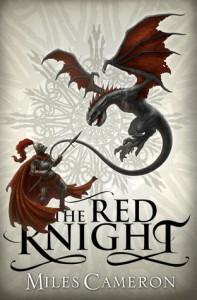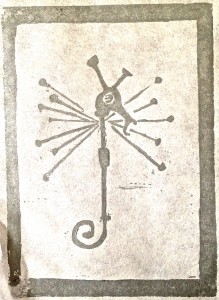

If you haven’t heard of it, here is the description from the Amazon listing:
This all-new definitive guide to writing imaginative fiction takes a completely novel approach and fully exploits the visual nature of fantasy through original drawings, maps, renderings, and exercises to create a spectacularly beautiful and inspiring object. Employing an accessible, example-rich approach, Wonderbook energizes and motivates while also providing practical, nuts-and-bolts information needed to improve as a writer. Aimed at aspiring and intermediate-level writers, Wonderbook includes helpful sidebars and essays from some of the biggest names in fantasy today, such as George R. R. Martin, Lev Grossman, Neil Gaiman, Michael Moorcock, Catherynne M. Valente, and Karen Joy Fowler, to name a few.
It’s a freaking GORGEOUS book (to the point where I’m surprised by the relatively low price, given how glossy it is). I spent some of last night flipping through and being delighted. I’m looking forward to a more careful read. Highly recommended.
...
 A bajillion years ago, when you could send the Science Fiction Book Club $.11 and get 11 books back, I signed up, receiving a fabulous armful particularly valuable back in the days when the Internet was just kicking off.
A bajillion years ago, when you could send the Science Fiction Book Club $.11 and get 11 books back, I signed up, receiving a fabulous armful particularly valuable back in the days when the Internet was just kicking off.
One of the 11 was P.C. Hodgell’s fantasy novel, Godstalk. I recently reread it when I found it and its sequel were available in the form of a single e-book, The God Stalker Chronicles.
I loved that book for its density of innovation as well as its creation of Tai-tastigon, a city is vividly alive as any other in speculative fiction, as evocative as Ambergris or Gormenghast, as alluring and perilous as Fritz Leiber’s Lankhmar, as historied as Minas Tirith or fictional London or any of the cities George R.R. Martin evokes so well.
And I loved it for its heroine, Jamethiel. She comes to the reader as a semi-amnesiac, unsure of exactly what lies in her past and bearing, as such heroes and heroines often too, a magical object. Or agical objects. Those objects shaped my naming convention for magical objects and remain as lovely as when I first encountered them: the Ivory Knife, the Book Bound in Pale Leather and the Serpent Skin Cloak.
Their bearer enters the city of Tai-tastigon and swiftly is embroiled in the doings of several groups of characters, including the staff of a local tavern, the Thieves Guild, assorted priests and gods/goddesses, the rooftop-dwelling Cloudies, and assorted bandits, allies, and felines, all of whom turn out to be more connected and in more mysterious ways than one would expect. I am an inveterate re-reader. More so in the days when I didn’t have the ability to download just about anything from the Internet, but even so still a habit I indulge in. Godstalk stood up to multiple rereads over the decades and shaped my expectations for fantasy novels ever since. It set a pretty high bar.
I loved Godstalk to death and managed to find its sequel Dark of the Moon much later. It always frustrated me not be able to find others in the series. Therefore I was overjoyed to find out that that not only were there more in the series but that they were available in electronic form. I’m halfway through the third book, Seeker’s Bane, and looking forward to the next three.
One of the things that makes returning to the book so satisfying is the heroine Jamie. Her flaws as well as her strengths are written deeply, shaping her actions inevitably and eloquently. The author takes us deep into Jamie’s head, letting us watch her development as well as her struggle with her complicated existence.
The main source of Jamie’s struggle is her adherence to the Kencyr code of honor, a trait that makes her a hero in the classic sense, someone to look up to and emulate, and which often talks directly about the nature of honor. Here’s a passage I just hit in Seeker’s Bane:
Trust honor, Immalai had said.
yes. For her, balanced on the knife’s edge, honor was more than life, its loss infinitely worse than death. And part of honor was taking responsibility for one’s actions and choices, over and over, as long as one acted or chose.
Jamie is complex and compelling. Her twin brother, Tori, begins to share the viewpoint in the second book and is interesting in his own right, but Jamie is rightly the core of the series. As I’m reading through the series, it’s a pleasure as a reader to watch her history unfold even as her personality is sharpened and shaped. As a writer, it’s a terrific lesson on the effectiveness of going deep into a character’s head.
Fantasy books and series that share this depth of character development:
...
 In the past I’ve found the promotional bag of books from a con can vary widely in terms of quality. One treasure that emerged from my World Fantasy Convention bag, though, is THE RED KNIGHT by Miles Cameron. I’m about to send my copy off to a friend, and I thought I’d recommend it to other folks as well.
In the past I’ve found the promotional bag of books from a con can vary widely in terms of quality. One treasure that emerged from my World Fantasy Convention bag, though, is THE RED KNIGHT by Miles Cameron. I’m about to send my copy off to a friend, and I thought I’d recommend it to other folks as well.
In flavor, it reminds me a little of what I like about Joe Abercrombie – a nice grittiness to the characters, as well as a melange of viewpoints that end up weaving together coherently to deliver a story that pulls you along. The social structure feels medieval, full of knights and squires, but while noble by birth, most are not noble in nature. I like strong female characters in my fiction, and there’s plenty of them in here, including some older ones, which I appreciate. The fighting is nicely choreographed and realistic, without the description ever getting tedious.
It’s the usual some dark mystic force is invading sort of plotline, but it’s enjoyable and tense. I’m a fan of big fat fantasy novels, and this is both engaging and highly satisfactory, to the point where I’m eager to read the next, since THE RED KNIGHT is the first of a trilogy. The jacket says Miles Cameron writes historical fiction under another name, and I’m going to poke around and see if I can’t find his other work, since I enjoyed this so much.
...

Erin Morgenstern’s THE NIGHT CIRCUS was a terrific read and one that will delight fans of THE PRESTIGE and CARTER BEATS THE DEVIL. Lots of gorgeous and beautiful description of a highly evocative setting and the love story that plays out against it.
While on a visit to Baltimore recently, I was introduced to Joe Hill’s graphic horror novel, LOCKE AND KEY. I read the first one, and am looking forward to the rest.
THE PALACE JOB by Patrick Weekes was a terrific romp of a fantasy read, and is an Ocean’s Eleven type adventure played out against a fantasy setting.
Jonathan Wood’s NO HERO and YESTERDAY’S HERO reminded me of a less frenetic Charlie Stross. Another fun and frothy urban fantasy was Jennifer Willis’ VALHALLA.
Love Joe Lansdale, but I’m reading him slowly in order to spread out the cost of getting all the Hap and Leonard novels. September held THE TWO-BEAR MAMBO as well as a collection of short fiction, BUMPER CROP.
I go back every few years to read E.F. Benson’s Mapp and Lucia novels. Why doesn’t someone do a fantasy version of these? That would be so awesome.
THE WEIRD: A COMPENDIUM and THE APEX BOOK OF WORLD SCIENCE FICTION are both books that I am dipping into periodically, spacing them out so I can think about the stories, rather than absorb them all in one long read.
THE BANDIT KING by Lilith Saintcrow is a fantasy romance, the sequel to THE HEDGEWITCH QUEEN. I’ve yet to find a Saintcrow book that I haven’t enjoyed.
In nonfiction, I’ve been reading these:
...
I’m headed into the city this evening to hear John Scalzi read from Fuzzy Nation. I’ve loved the Little Fuzzy books (and I’ll note that there’s a bunch of his stuff free for e-readers) since discovering them as a teenager and found a book club edition of the first two this weekend at the thrift store. I’d forgotten what a tear jerker the first one is, and the anti-corporate message seems even more timely than usual. I haven’t read Fuzzy Nation yet, but I’m picking it up today and looking forward to it. I’m also fascinated by the idea that Scalzi’s written fan fiction – it opens up some interesting questions about that debate.
I recommend the first book for people working on learning how to create emotional depth, which a couple of writers have mentioned to me lately. Any book that has me welling up with tears is doing its job right in that regard. I’m taking my Writing F&SF class to this reading so they can be inspired by seeing a writer in action – maybe Scalzi will get them to cry (in a good way).
...
Dragons, dragons, dragons – so many writers have written about them in one form or another. Here’s ten books featuring dragons for fellow lovers of the form.
...
I blogged a couple of weeks ago about books I’d recommend for writers focusing on their craft. This time I’m choosing books that are handy to have on a nearby shelf, particularly books that help spark new ideas, whether it’s at the overall story or plot level, or bits that can be used to adorn a story, the tiny embellishments like filagree or the lines in the Book of Kells, because we can always use new idea, little shocks, a kick in the head that turns the world askew in a way that lets us see it more clearly.
...
Tired of the usual stuff? Here’s five fantasy classics that you may have missed.
Jirel of Joiry, by C. L. Moore. If you love Red Sonja, Jirel is the heroine for you, worthy of company with Conan or Imaro. Indiana-born Moore was one of the first women to write in the sword and sorcery genre.
Tomoe Gozen, by Jessica Amanda Salmonson. Another strong woman is embodied in Tomoe Gozen, a samurai in the first of a trilogy set in a richly-realized and fabulous 12th century Japan.
Unquenchable Fire by Rachel Pollack. Beautiful and ornate, set in an alternate America that seems sadly unlikely, this is a fabulous take on spirituality today.
Monday Begins on Saturday, by Arkadi and Boris Strugatski. A young computer programmer is recruited for a Russian Institute devoted to the paranormal in a book that’s more Office Space than X-Files. One of my top ten favorite books of all time.
Green Phoenix, by Thomas Burnett Swann. Swann is sadly neglected and all of his books are worth picking up, but this is one of the lovelier ones. He does more interesting things with classic mythology than most authors.
...
When I’m teaching, I do bring some books to class in order to point students toward them. I don’t think books are a substitute for the act of writing, but they can help focus and direct your practice and give you a list of things to work on that might not otherwise occur to you. Here’s a list of my top ten for speculative fiction writers focusing on their craft. I was sad to find some not available on the Kindle, but where possible, I’ve pointed to the e-version.
2016 addendum! I still stand by all these, but here are five more:
Million Dollar Outlines
Storyteller by Kate Wilhelm
talk the Talk: A Dialogue Workshop for Scriptwriters by Penny Penniston
The Three Jaguars: A Comic about Art, Business, Life by M.C.A. Hogarth
Wonderbook: The Illustrated Guide to Creating Imaginative Fiction by Jeff VanderMeer. Worth it just for the pretty illustrations and marvelous charts produced by Jeremy Zerfoss in collaboration with VanderMeer, but also jam-packed with good and interesting writing advice that I have found best absorbed in small chunks, dipping into the book now and again for inspiration.
...
Want access to a lively community of writers and readers, free writing classes, co-working sessions, special speakers, weekly writing games, random pictures and MORE for as little as $2? Check out Cat’s Patreon campaign.

"(On the writing F&SF workshop) Wanted to crow and say thanks: the first story I wrote after taking your class was my very first sale. Coincidence? nah….thanks so much."

(fantasy short story) The Wizard Niccolo was not happy. At the age of 183—youthful for a wizard, but improbable for an ordinary human—he had thought certain things well out of his life. Sudden changes in his daily routine were one. And romance was another—even if it was his familiar’s romance, and not his own.


This site is protected by reCAPTCHA and the Google Privacy Policy and Terms of Service apply. This site is a participant in the Amazon Services LLC Associates Program, an affiliate advertising program designed to provide a means for sites to earn advertising fees by advertising and linking to Amazon.com.